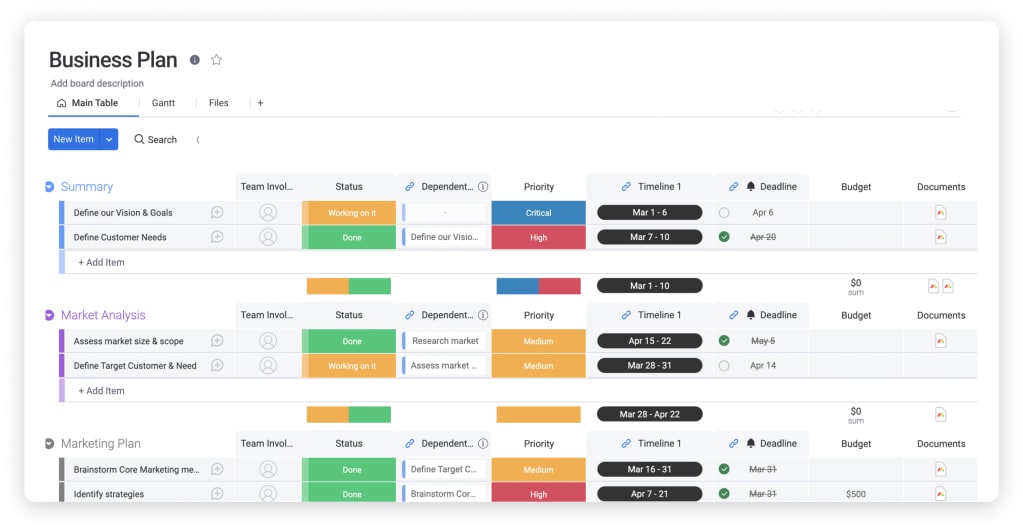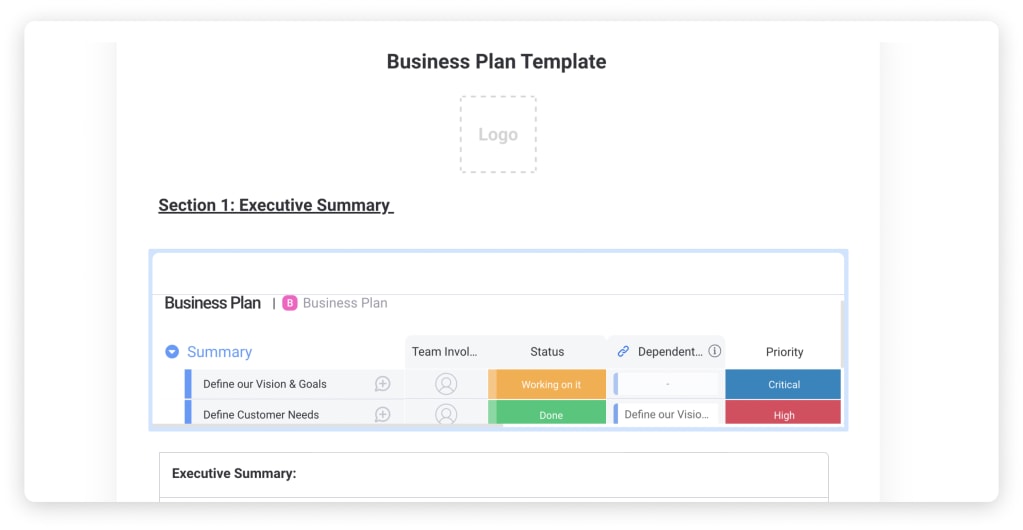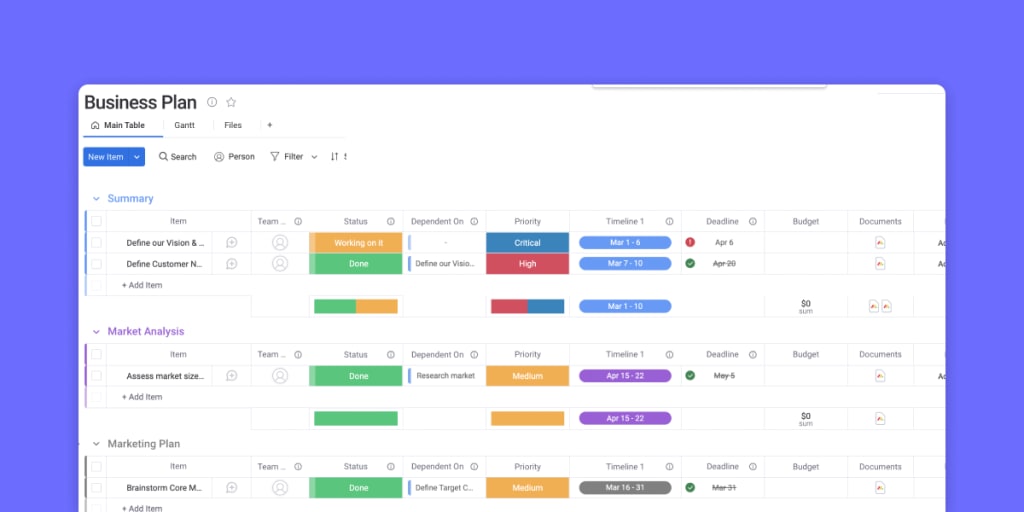When circumstances change in business, and your employees aren’t made aware, you could quickly find yourself running around trying to put out fires. Important client updates and industry news can force you to act fast if you want things to keep running smoothly.
A business memo template is the perfect remedy to slow or incomplete internal communications in an instant — you can draw up an announcement and broadcast it to your team, department, or the entire company. In this article, we’ll cover what a business memo template is, its benefits, and share a fully customizable template you can start using on monday.com today.
What is a business memo template?
A business memo template provides a simple formula you can use to lay out internal messages to employees or peers. The template gives you an outline for all the information you need to broadcast a company-wide message — from intended recipients to the subject line, and how to start each section with clarity and purpose.
Business memo templates can be more detailed, too. For example, you could use one to inform the sender how to organize the information in a way that’s concise yet encompasses the message completely. This could mean that the template features paragraph outlines and proper spacing to accommodate headers and subheaders.
A business memo template enables a smooth-flowing narrative, structuring the memo in such a way that readers can digest the information without getting bogged down in details.Why use a business memo template?
First and foremost, business memo templates can speed up your internal communication, which should help departments run like well-oiled machines. 86% of employees believe that company failures stem from a lack of clear communication, so streamlining employee interactions could be critical for averting disaster. Even in the case of disruptions like breaking news that affects your business or unexpected client requests, you can adapt quickly and respond.
Business memos typically go out to a large group of employees within a company, and the template helps you craft that message while factoring in comprehension and scannability. The template can save company time as it can be filled out quickly with any up-to-date information that employees need to know.
Keep connected in a more remote workplace
In 2020, as many as 71% of workers were forced to start working remotely, further emphasizing the importance of clear communication to keep everyone on the same page. A lack of in-person meetings can slow down your communications unless you effectively keep in touch online.
Avoid misunderstandings with clearer messages
The uniform structure of the business memo template boosts comprehension among employees and peers, helping them act on the information quickly. The faster you can get the update to everyone it relates to, the better you’ll be able to respond to it as a single unit on a company-wide level.
But enough about why you should use business memo templates, let’s take a look at some actual examples and when to use them.
What are some examples of business memo templates?
Let’s explore some different examples of business memo templates for various occasions.
1. Action plan business memo templates

With this type of template, you can highlight a straightforward course of action for your employees to take after they finish reading the memo. Clarifying the next steps in this way ensures that everyone knows what they need to do while minimizing disruptions and time spent responding to questions.
A bulleted list can be a useful tool in this case, as they can help you construct a scannable format for your memo, allowing recipients to sift through the important points. That means less time spent trawling through unnecessary details that don’t point to actions to take. Include any additional information in this template that recipients might need. For example, provide contact details for any queries employees may have, or links to relevant resources.
2. Important update business memo template

Use an important update memo to deliver news to employees concerning unexpected events and changes in circumstance. For instance, the COVID-19 pandemic took the world by surprise in 2020, and caused dramatic shifts in company protocols. As the business world is constantly evolving and changing with time, a memo like this one can be useful for updating employees on current protocols — like needing to wear a mask at work — and staying in tandem with your country’s regulations. A simple list of updated protocols will suffice, along with the contact details of who employees can reach out to if they have any related questions.
3. Project update business memo template

Update your team on a particular project with this memo template. Enter every detail from relevant background information to the various stages the project must go through. List anyone responsible for the management and coordination of the project, along with their contact information. Detail any project software tools employees will use for the project covering everything from communication to collaboration.
monday.com’s business memo template
Using monday.com to create a business memo template takes common memos to the next level with the ability to plug in information pertaining to updates and shifts in direction with projects in real-time. The template will guide your message to ensure optimal clarity, providing every recipient with clear next steps or instructions to comply with the contents.
The template includes all the ingredients for an effective memo: instructions on delivery, a clear structure to frame your message, and a guide to how to break it down for a smooth-flowing narrative. While you can craft a memo from scratch, you save a lot of time when you use a smart premade template.

Plus, as part of the monday.com Work OS, you have a much better platform for sharing memos with specific employees than email. You can create specific boards and teams, making it easy to highlight a vital project-specific memo with the right people.
To make sure that everyone has seen the memo, you can rely on reactions like likes or comments, instead of having to confirm email responses one at a time.
And with monday.com’s advanced reporting, you can see how memos affect the productivity on different projects. With monday.com anything you upload is private and confidential, and you can choose which employees get access to view or edit any document, board, or message.

The powerful monday.com Work OS also lets you customize workflows so you can set your employees up for success. Instead of leaving the memo followup to chance, you can outline it from start to finish. Create and assign actionable to-do lists based on required next steps from the memo, and your employees can hit the ground running.
Business memo template tips and tricks
With a business memo, the goal is to be succinct. Ideally, with this type of company-wide message, you want to leave employees with a clear idea of what actions they need to take immediately. To set them up for success, stick to bullet points — they’re both scannable and easy to digest.
Let’s dive into our top tips for making the most of a business memo template.
Add some personality
Memos can sometimes come across as robotic in tone, which can make them fall on deaf ears. Let your employees know that there’s a human behind the memo by injecting personality into the introduction or sign-off, as this could help with engagement levels. Our template provides a general structure for your messaging, but also leaves space for you to add your own company voice.
Include contact information or further resources
Always outline contact information in your memos, as there’s a strong chance some employees will have questions. The last thing you want is to have employees that could be taking action left confused and unsure who they can reach out to with their pressing concerns about the memo’s content.
Tailor the memo to the audience
Always tailor the content of your memo to the audience. If you’re sending a message out to a large group of frontline employees, you’ll want to avoid language that’s overly formal. Getting the tone right can be challenging, but having a template to structure your words can leave you more time to focus on getting the wording right.
FAQs about business memo templates
How do you write a business memo?
To write an effective business memo, you need to distill all information you want to communicate into a neatly-packaged email or post. Lean on the template to guide your thoughts, but don’t be overly reliant on it if you have your own ideas for reaching your audience.
Start with the primary purpose of the memo, and from there, build the memo out with all the relevant supporting information and resources. Use action plan lists throughout to make the content scannable and provide recipients with clear next steps to take. Also include contact information so that employees can reach out with any concerns they have.
What is a business memo format?
The business memo format is simply a type of message that’s addressed to a large group of employees within a company. It’s comparable to the standard work email, yet since it addresses many individuals, it needs to be granular and concise.
With memo formats, the key is to include all relevant information in the initial message to avoid a needless back-and-forth that can delay the necessary actions. Our template sticks to a basic format similar to an email — subject, introduction, and main body. The simple and familiar structure helps your employees absorb the necessary information quickly.
What should be included in a business memo?
A business memo typically includes a few key elements:
- A clear and concise subject line
- A short introduction — the why of the email
- The main text, or a bullet list of actions steps or relevant changes
- Relevant contact person and resources
The subject line should encapsulate the purpose of the business memo in a sentence. For example, if it pertains to the moving of your main office, you could use, “Update regarding moving offices.”
The introduction should be short, outline the reasons for the memo, and set up employee expectations. In the main body of the memo, you can either use headers to divide up content and make it easy to read, or you can introduce bullet-point lists to summarize the highlights and make a scannable text.
